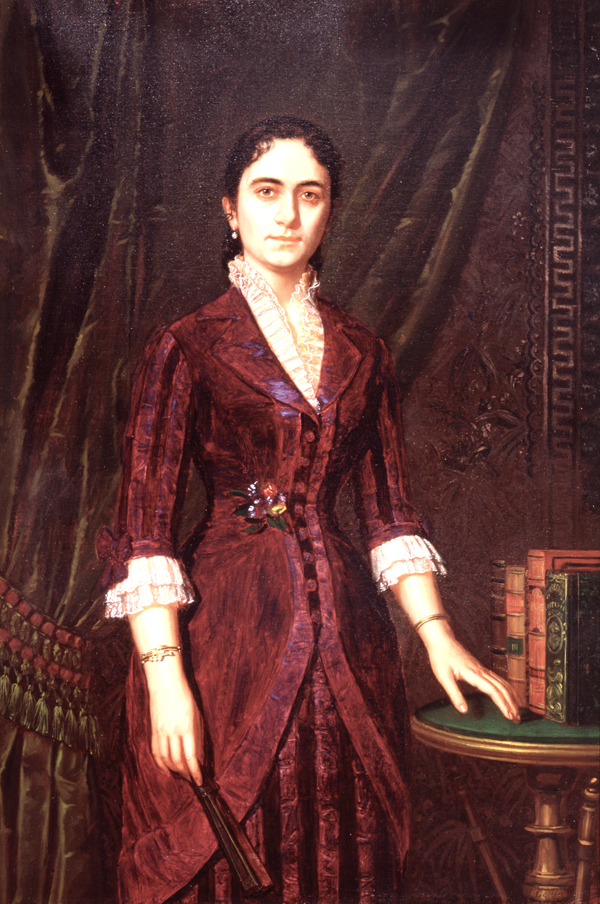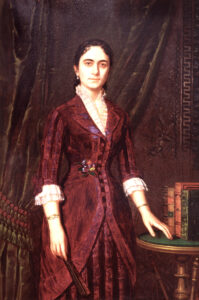Léona Queyrouze
New Orleans–born Léona Queyrouze was a prolific poet, writer, and essayist.

Louisiana State Museum
Portrait of Léona Queyrouze by John Genin.
A prolific poet, writer, essayist, and musician, Léona Queyrouze is remembered as one of the emblematic white Creole writers who honored their linguistic, cultural, and historical French heritage at the turn of the nineteenth and twentieth centuries. Raised among the French cultural elite of New Orleans, she benefited from a rigorous classical education and went on to create poetry characterized by its intimate style and feminine introspection.
Biographical Overview
Marie Léona Queyrouze was born in New Orleans on February 23, 1861. Her mother, Anne Marie Clara Tertrou, was from a well-known white Creole family that descended from French aristocracy and had lived in Louisiana for several generations. In 1857 Tertrou married Léon Queyrouze, with whom she had Léona and a son, Maxime, in 1866. Léon Queyrouze was a Frenchman who had left his country and settled in New Orleans in 1835. He was a successful wine merchant who played an important role in preserving French culture in Louisiana by being involved with the Union Française and as one of the founders of the Athénée Louisianais, a benevolent society dedicated to supporting the French language in areas of science, literature, and the arts.
Léona Queyrouze was raised in a highly educated environment. She learned mathematics, music, and many languages (Greek, Latin, German, Spanish), in addition to being fluent in French and English. Growing up, Léona participated in the salons and parties held by her family with the Francophone intelligentsia of New Orleans. There she met important figures that she kept in touch with for the rest of her life, including Alfred Mercier, Charles Gayarré, Alcée Fortier, Louis Placide Canonge, Jean Sylvain Gentil, Charles H. J. Testut, Dominique Rouquette, and Victor Rillieux. Many shared their work with her; some would write poetry dedicated to her. She was invited to their literary circles, first for her musical talent, as she was a gifted pianist who wrote her own pieces, later as a literary critic and poet. In 1887 she met Lafcadio Hearn in New Orleans and initiated a long literary friendship. They wrote many poems to one another and maintained correspondence for many years after Hearn left for the West Indies and later moved to Japan. In 1933 Queyrouze published a biographical book in his honor entitled The Idyl: My Personal Reminiscences of Lafcadio Hearn.
In 1901 she married Pierre Etienne Barel, which marked the slowing of her publications, even though she kept writing until her death on January 3, 1938.
Literary Career
In 1886 Queyrouze took on her most famous pen name, Constant Beauvais, in homage to one of her ancestors. She hinted in the poem “Pseudonyme” that it was a way to make people forget that she was a woman. Queyrouze probably also used the pseudonym to distance her private and public personas. She wrote many essays and articles expressing opinions that received fierce criticism, such as “The Race Problem Logically Discussed” (1889), in which she denounced racial injustice and invited Black people to pursue education and cultural advancement to overcome prejudice and achieve true equality. She wrote two short stories (entitled “Nouvelle” and “Un dernier chapître”) published in the Indépendant in New York, while she lived there between 1885 and 1886.
Queyrouze’s preferred genre, however, was poetry. She published over a hundred poems, most of which are sonnets written in French, mainly in the Louisiana newspapers L’Abeille de la Nouvelle-Orléans and the Times-Picayune and the literary magazine Les Comptes-Rendus de l’Athénée Louisianais. She deplored the loss of French culture in a deeply Americanized society and celebrated French history and literature. Her writings also revealed a personal take on the female role and expectations. Cleverly implied and illustrated, she explored women’s desires and sexuality, and offered a more modern vision of what an independent woman could achieve, following the model of two French writers with whom she was often compared, Madame de Staël and George Sand.
